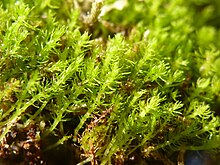| Takakia lepidozioides | |
|---|---|
 | |
| Takakia lepidoziodes on a damp slope above Takakia Lake, Haida Gwaii | |
| Scientific classification | |
| Kingdom: | Plantae |
| Division: | Bryophyta |
| Subdivision: | Takakiophytina |
| Class: | Takakiopsida |
| Order: | Takakiales |
| Family: | Takakiaceae |
| Genus: | Takakia |
| Species: | T. lepidozioides |
| Binomial name | |
| Takakia lepidozioides | |
Takakia lepidozioides is a species of moss in the Takakiaceae family, one of two species of Takakia .